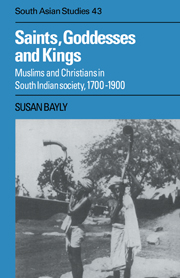Book contents
- Frontmatter
- Contents
- List of plates
- List of maps
- Preface
- Note on transliteration
- List of abbreviations
- Introduction
- Part I
- 1 South Indian religion and society
- 2 The development of Muslim society in Tamilnad
- 3 The Muslim religious tradition in south India
- 4 The south Indian state and the creation of Muslim community
- 5 Warrior martyr pirs in the eighteenth century
- 6 The final period of nawabi rule in the Carnatic
- Part II
- Select glossary
- Bibliography
- Index
- CAMBRIDGE SOUTH ASIAN STUDIES
- Plate section
6 - The final period of nawabi rule in the Carnatic
from Part I
Published online by Cambridge University Press: 04 December 2009
- Frontmatter
- Contents
- List of plates
- List of maps
- Preface
- Note on transliteration
- List of abbreviations
- Introduction
- Part I
- 1 South Indian religion and society
- 2 The development of Muslim society in Tamilnad
- 3 The Muslim religious tradition in south India
- 4 The south Indian state and the creation of Muslim community
- 5 Warrior martyr pirs in the eighteenth century
- 6 The final period of nawabi rule in the Carnatic
- Part II
- Select glossary
- Bibliography
- Index
- CAMBRIDGE SOUTH ASIAN STUDIES
- Plate section
Summary
Having looked at Khan ‘the rebel commandant’ and ‘Khan Sahib’ the pir and power divinity, this chapter now turns to the Walahjahs' problems of statecraft and dominion-building in the years following the move to Madras. Despite the regime's strategic weaknesses, despite its dependence on the East India Company and the chronic indebtedness which led to the much-debated attack on Tanjore, the Walahjahs and their retainers continued with the recruitment of Sufis and with the building and endowment of mosques, shrines and other pious foundations. All these benefactions were assertions of power. They proclaimed that the nawab was still active, and still capable of endowing his realm with new repositories of barakat. In this sense the Walahjahs could even claim to be enlarging their domain since they were adding to its networks of supernatural vilayats, and it was out of these that the Indian Muslim ruler constructed his ‘real’ dominion.
At the same time the Walahjahs were still making lavish benefactions to the great established foundations. Much of this largesse was still directed to such long-standing beneficiaries as the Nathar Wali dargah and the Vellore Hazarat Makan, but from the last quarter of the eighteenthcentury the Walahjahs began to strike out in new directions, seeking particularly to forge links with the dargah of Shahul Hamid of Nagore. This was partly a reflection of the shrine's exceptional power and sanctity for south Indian worshippers: according to one widely known formula, seven journeys of pilgrimage to Nagore confer the same merit as a single haj or pilgrimage to Mecca.
- Type
- Chapter
- Information
- Saints, Goddesses and KingsMuslims and Christians in South Indian Society, 1700–1900, pp. 216 - 238Publisher: Cambridge University PressPrint publication year: 1990



